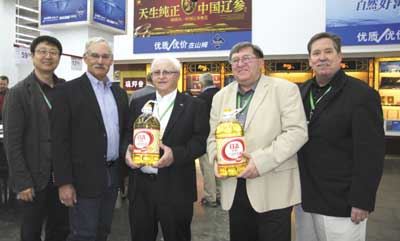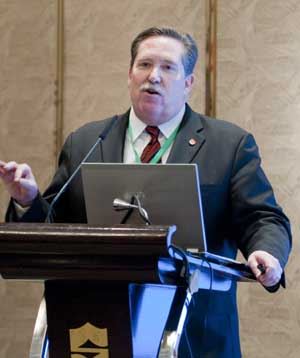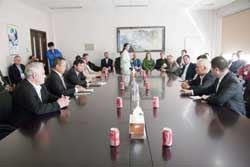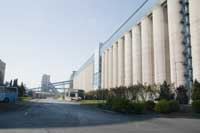|
Building Bridges To China For U.S. Soy Is Goal No. 1
5th In A Series
JOHN M. LAROSE &
BETTY VALLE GEGG-NAEGER
MidAmerica Farmer Grower
DALIAN, CHINA
Creating demand for soy in China is a day and night endeavor for Paul Burke, North Asia regional director for the U.S. Soybean Export Council, headquartered in Beijing, China. He centers his efforts in China, Japan, Taiwan and Korea. Recently, Burke, Larry Marek, a director of the United Soybean Board (USB) and an Iowa farmer, and Richard Wilkins, Treasurer of the American Soybean Association (ASA) and a Delaware farmer, joined the USDA Agricultural Trade Mission to China led by U.S. Under Secretary of Agriculture, Michael Scuse.
“Through this Agricultural Trade Mission we wanted to showcase two things,” Burke said. “One is that soy is the largest U.S. export and largest U.S. ag export to China; in that capacity we want to show leadership among all the other commodities and show support for the Foreign Agriculture Service (FAS) USDA and what they do for us here. Also we wanted to help get the message out about the kind of marketing programs that work here in China.”
Last year the value of U.S. soybean exports to China was $15 billion represented by 23 million metric tons. Global pricing the last marketing year, which ended in August showed shipments to China had decreased, however the real story is the U.S. producers sold expensive soybeans.
“This year the U.S. will be setting a record of total agricultural exports, and total soybean exports to China and at the end of the year we want to see how China's imports of U.S. soybeans affect the end-of-year stocks-to-use ratio,” Burke said. “In the last five or six years, the year-end stocks-to-use ratio has been very low in the United States. That's really what determines whether the U.S. soybean farmers are getting a great price or not. I want to caution people not to look at whether we exported more this year than last year but to look at the end-of-year stocks-to-use ratio, because when you have clean bins, the U.S. soybean farmers are making more money.”
Burke expects this year to be a very tight year. “We know that already, because in the United States we saw the price of soybeans go up to $15 a bushel just a couple of weeks ago. That has a lot to do with the Chinese buying even more soybeans than people had expected, and the crush in the United States being larger than people had intended; and to that extent soybean loads are being redirected from China to the U.S. east coast. That’s an indication that it’s going to be a very healthy for U.S. soybean farmers end-of-year stocks-to-use ratio. I think that will impact planting decisions – from what I've heard, there will be more soybean acres this year – but I think it's a combination of weather and the price ratio between the November corn futures and the soybean futures.”
On May 5, 2014 the U.S. Agricultural Trade Mission delegation met with the executives of China National Cereals, Oils and Foodstuffs Corporation (COFCO) and the Jiusan Group soybean crushing facilities at the Port of Dalian, China. During one of the meetings Wang Qing, Deputy General Manager, Oilseed Processing Division, COFCO Group (COFCO) joined the executive meeting to express some major concerns he had, to the U.S. Agricultural Trade Mission delegation.

Shown displaying a bottle of soybean oil in a Sam’s Club Store in Dalian, China,
that had been processed and labeled using oil produced from U.S. soybeans are
from left to right, Zhang Xiaoping, USSEC China Country Director, Under Secretary Michael Scuse,
Larry Marek, Director, USB, Richard Wilkins Treasurer ASA and
Paul Burke North Asia regional director for the U.S. Soybean Export Council - North Asia. 7139
Photos by John LaRose
Specifically, Wang stated U.S. soybeans are tested at 35 percent protein at uploading at U.S. ports, but only 32 percent protein when received at China ports. Only 1.49 percent foreign matter at uploading at U.S. ports, but 2.2 percent foreign matter when receiving in China’s ports. He also expressed concern with the increase in dust problems when unloading, polluting the environment. Wang went on to compare U.S. soybeans to South American soybeans. He stated that South American soybeans are lower priced with higher protein and oil content than U.S. soybeans and South American soybeans contain 1 percent foreign matter. Wang asked the Under Secretary of Agriculture, what are the causes of the quality problems of U.S. beans; handling, transportation or vessels? Where does the contamination occur?
Under Secretary of Agriculture Scuse assured Wang that he would look into the matter.
After the meeting with Wang and the Jiusan soybean crusher executives, MAFG interviewed Paul Burke, North Asia regional director for the U.S. Soybean Export Council and was asked for his thoughts on Wang’s concerns.
Burke stated, “Wang Qing, is the Deputy General Manager, of the Oilseed Processing Division in the COFCO Group, the second largest importer of soybeans into China which includes all of the COFCO crushing plants. If COFCO was a country it would be number two after China in terms of total volume they import and process. This is a very important company. Because it's a state owned enterprise, COFCO is associated closely with the Chinese government. So Wang’s comments are definitely important.”
“Wang chose to take this unique opportunity to talk to a very high level official in the United States Department of Agriculture, which is in charge of export grading for all U.S. commodity shipments,” Burke related. “He stated that what the USDA is telling them on their export grades is not what they feel they are receiving. So I think he took the opportunity to express to as high a level as he could reach in the USDA that the Chinese have concerns about the current grading system.”
“The U.S. Soy Industry is working cooperatively with the North American Export Grain Association with the USDA and the Chinese agency that does the inspection of imports, Administration of Quality Supervision, Inspection and Quarantine, (AQSIQ), on this very question. In fact, this week back in Dalian my associate will meet with AQSIQ officials to do a port facility inspection. We will be planning a vessel comparison study to compare six vessels and our grading systems so we can identify where the U.S. system differs from the Chinese system. We will be looking for some common ground, so when Wang receives the USDA grading system certificate he can compare it to the Chinese grades.

Paul Burke, North Asia regional director for the U.S. Soybean Export Council,
headquartered in Beijing, China explains the things they wanted to showcase
through this Agricultural Trade Mission.
“Wang is aware of this vessel comparison study and COFCO has actually cooperated on this project in the past. I think he was letting off steam, but I think it shows he is very astute in recognizing that he was hosting the under secretary of the agency that gives him export grade certificates of soybeans. He told him I am having some issues, a little bit of heartburn about it. He was taking advantage of that, but as I mentioned in my presentation yesterday that USSEC targets 15 firms here in China for our trade servicing and technical servicing programs. COFCO is number two. They’re the second largest importer of U.S. soybeans in China. And their volume exceeds all other single country export markets. So COFCO’s concerns should be acknowledged”
China buys about 25 percent of the total U.S. soybean production. So every fourth row of a U.S. soybean field is going to China. The value of that row of soybeans is dependent on Chinese demand. China imports 60 percent of U.S. soybean exports.
Burke is comfortable with the U.S. export future in China.
“Yes, I'm optimistic. I'm looking at a really long term macro trends,” Burke said. “China's government is very committed to urbanizing its population and developing its economy. There are going to be some economic crises that pop up in China in the next 20 years. It’s inevitable, it happens to every economy, but when you read what economists say about a country that's both growing economically and urbanizing at the same time, then your overall economic outlook should be bullish.
“Many countries in South America, Africa and other places are urbanizing now, with a lot of people moving from the country to the cities and they have no jobs,” Burke continued. “But here in China, it's economic growth and urbanization. Europe went through this, United States went through this, we went through this in Japan, Taiwan, Korea, and those are all signs that there is going to be a lot of growth here. So we are very optimistic that China will continue to grow it’s animal agriculture sector; it's feed sector will need more soybeans, more corn, they will import more of these in the future. Will there be some gaps in the economy, will there be some crises? Yes, but that is long term. The next 20 years still will be very bullish in terms of consumer demand, and to satiate that demand, soybean and grain imports can fill the need.”
Directors and other leaders from the American Soybean Association and United Soybean Board regularly visit China, northern Asia and all markets as frequently as possible.
“The traders here like to spend time with our directors because they use them as a reference to what they're reading in the media,” Burke said. “So they'll ask our directors about our planting intentions, how much of our future crop is sold, how much is in the bin.

United Soybean Board director Larry Marek (left) sat in on a discussion
with Under Secretary Michael Scuse during a business meeting with
COFCO Group’s oilseed processing management in Dalian, China.
“These folks are reading the same information that our traders and farmers read, but they want to measure what they're reading against what somebody who is really producing says. So we try to bring them into the marketplace all the time. They’re a very important asset to our efforts here.
Meeting the Washington County, Iowa farmer and USB Director, Larry Marek, who farms 1,700 acres of row crops near the Mississippi River, helps them put a face to the U.S. soybeans they purchase. Marek is a fifth generation farmer who raises soybeans in a rotation with corn, forage and grass for the cattle herd.
“We (the USB) do a lot of research, but we also do a lot of promotion,” Marek explained. “We produce way more soybeans than we can use in our country and we have been very successful in promoting sales to China. We are visiting a lot of companies that do purchase from us at the present time and some of these purchasers reciprocate with visits to our state and our country. They like to have a personal connection to the individuals, farmers and groups with whom they purchase beans. A lot of these individuals have actually been on farms that have produced the soybeans.”
Burke explained that the previous evening they had dinner with the Jilin Grain Group, the fifth largest importer of soybeans into China. “It was a nice evening meeting with the soybean buyers and importers from that group, five individuals who make decisions about purchasing 6 million metric tons of soybeans every year,” he explained. “They were peppering us with questions, interlaced with ‘how many kids do you have?’ ‘how much have you forwarded, contracted and at what price?’ Then we pulled out a balance sheet to show the cost of production per acre of land in Iowa, basically Larry Marek’s particular operation, and what his actual cost of production is. Then we kept stressing, that's just Larry Marek’s situation, it can be different from a farmer down the road and certainly different from a farmer in Delaware where Richard Wilkins lives. They wanted to know that, and then they pulled out a spreadsheet already prepared from information they received.”
Richard Wilkins, Treasurer ASA, and of Greenwood, Del. is a row crop producer. Wilkins farms 400 acres of soybeans, 400 acres of corn, 250 acres of wheat 100 acres of barley, 200 acres of vegetables, 250 acres of hay and raises 150 head of beef cattle.
It may seem like a matter of trust in the cost estimates, but Burke disputed that thought. “No, they trust Marek and Wilkins because they represent USB and ASA, they trust them because they are associated with the U.S. Soybean Export Council here,” Burke said. “They just are hungry for all this information to understand better the source of the soybeans which cost them a lot of money.”
Burke explained some of the issues of trade with China. “The U.S. soybean industry opened an office in China 32 years ago, and has organized teams to transfer animal agriculture production technology and management skills, to come to the United States and see the technology in practice as it's being utilized here. The rest of the U.S. agriculture sector became more involved around 1992.

Pictured is the Nissin Soybean Crusher
Port Facility in Dalian, China.
Soy is in great demand for specific breeds of fish, and it had to be in a production management systems that would not degrade the water. The USB has developed those technologies, and have been promoting those since 1992. The outcome is China's soybean consumption grew by 200 percent since 1992. Most of that increase in consumption has come through imported soy.”
“There will be a record import of world soybeans into China this year, but probably not the 70 million metric tons estimated by the USDA. Problems with the swine price/production cycle and avian influenza has influenced the swine and poultry sectors’ profitability in China and that will diminish this year’s soybean sales. It still will be a record import year, China will likely import 67 million metric tons this year, and the U.S. will have another record year for U.S. soy exports.”
“China’s soybean production is not going up, but the country’s consumption is growing radically and that is met through imported soy. From 1992 to 2014 the soybean use for soy foods has doubled,” said Burke.
“As incomes rise in China, they eat more animal protein but they’re also eating more soy,” Burke explained. “Chicken in a Chinese restaurant has soy in it. It has soy sauce, soy paste; it has tofu so the soy food is completely integrated. People’s diets have improved, they’re eating out more and they’re eating more soy. There’s going to come a day, and we think pretty soon, where China will actually import soy for human food consumption as well. That would be a really interesting game changer.”
“About 72 percent of the vegetable protein in animal rations is made up of soy meal. The feed industry, the animal agriculture industry continues to consolidate, continues to get larger; backyard operators who don’t use formulated feeds are going out of business as the Chinese are using more and more formulated feeds,” added Burke.
Currently USSEC is promoting a new aquaculture production management system called Intensive Pond Aquaculture (IPA). This system has the potential to double pond yields while not negatively impacting the pond water quality. The IPA system actually pulls the fecal material out of the water so that they have an organic fertilizer to sell and it’s all based on soybean technology, extruded pellets feeds. USSEC’s aquaculture program targets species that can consume up to 50 percent soy inclusion rate in their rations and they get a feed diversion rate of 1 to 1.3. What I would mention is when we started in aquaculture in 1992, zero soybean meal was used and now over 7 million metric tons of soybean meal is used in the aquaculture industry in China.
“That’s going to grow, barring any economic downturns which you never can predict, about 5 percent a year,” Burke said. “So we’re looking at an increase of 5 percent a year in feed production here in China for the next 20 years. The sectors that we target, there’s steady growth in the area of swine, layer, broiler, aquaculture production, and slower growth in the area of beef.
“At one point our market share was at 78 percent and now we’re down to like 36 percent,” he said. The demand for Brazilian and Argentinean soy has increased. So that spurs the USB to consider a new strategic phase to differentiate U.S. soy from that of other countries and create demand for U.S. soy. Now more and more of what we’re doing is, focusing on how we can create demand specifically for U.S. soy,” said Burke.
“One of our goals is to create awareness within China of the unique and intrinsic value of U.S. soybeans and try to put a value on those. The intrinsic value that we’re promoting is that U.S. soybeans have basically higher essential amino acids, or as high as competitive sources. This is research that’s being done around the world; it’s funded by the United Soybean Board in the United States.”
“In addition to the USB funded research the Minnesota and North Dakota soybean boards, have invested in this research and has put a real value on U.S. soybeans and is differentiating them not just in China but the global marketplace.
An additional extra value that we are promoting is that U.S. soybean farmers are a reliable supplier of soybeans. We had a drought two years ago, worst drought in 20 years, we still had the fourth largest soybean crop, because we’ve adopted the technology, we’ve adopted the conservation practices to sustain our productivity. Even if we have a drought in one part of the United States, we will be able to supply the soybeans that China needs. Our delivery system is sound.”
“Last year we had a conference with the U.S. Poultry and Egg Export Council, U.S. Grains Council and the U.S. Soybean Export Council and talked about poultry feed and production safety, for the Chinese industry. We did a similar conference with the U.S. Meat Export Federation, U.S. Grains Council and the U.S. Soybean Export Council about swine production. We’re going to be replicating those conferences again this year. And we’re doing work in a corporate social responsibility program with the China Soybean Industry Association where we look at how we can work collaboratively with the Chinese soybean industry.”
China’s soybean production is decreasing. That’s an alarming thing to Chinese policy makers. “We want to convince them that we’re not here to displace the Chinese soybean industry in China, we want to be part of the food security and food safety solution in China,” Burke said.
“I’m trying to convince members of the board not to look at market share in China, but look at volume, he added. “Look at how much of our volume of production is going to China. We’re never going to beat the Brazilians in market share as the demand here is just going to increase and the USA doesn’t have the available land to meet those future increases If we’re at 25 percent market share but a larger percentage of our volume is going to China, that’s a win for the U.S. soybean farmer.” ∆
Editor’s Note: MAFG has scheduled for July 18th “Illinois Swine Facility Feels Brunt of Chinese Hog Ban” and “China’s Ban On U.S. Pork Is ‘Game Changer’ For Market”
The four previously published articles on US China Trade can be viewed at www.mafg.net.
JOHN M. LAROSE: Publisher, MidAmerica Farmer Grower
BETTY VALLE GEGG-NAEGER: Senior Staff Writer, MidAmerica Farmer Grower
|
|